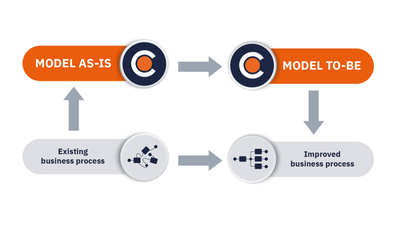What to look for in a business process modeling tool (and how Cardanit delivers)
Written by Nela Lazarevic
11 May 2021 · 5 min read

ESTECO has been known for decades for producing workflow-based engineering software. So since it embarked on creating Cardanit, a cloud-based tool for business process modeling, people have often asked: What does BPM have to do with engineering?
The origin of business process mapping can be traced back to the American Society of Mechanical engineers in 1921, when two pioneers of industrial engineering, Frank and Lillian Gilbreth presented: Process Charts, First Steps in Finding the One Best Way to Do Work.
The first ones to feel the urge to standardize process diagrams had the organization of big factories in mind - the more complex the process, the bigger the necessity and more evident the benefit of mapping it according to a widely used standard.
Today, big industries might be more concerned with the digital transformation, industry 4.0 and Agile development, but business process modeling is still about “finding the one best way to do work”. Not just for engineering organizations but for any business that is striving to succeed.
The standards for business process mapping have since evolved. Business Process Modeling and Notation (BPMN 2.0), by which Cardanit operates, provides a shared language between business and IT teams and enables automation. It is vendor-neutral, widely used and its diagrams can be exported in XML for use in third party tools.
From pit stops to onboarding: business processes are everywhere
At the thought of a business process, you might imagine assembly lines or e-commerce logistics, pizza delivery or an onboarding process for new employees. Whatever your first association to a business process is, you’re likely on the right track, because business processes are everywhere. We could go as far as to say that any business is only as efficient as its processes.

Let’s look at the pit stops in motorsports. They require skilled mechanics, efficient tools, and high performing mechanical parts. But above all, pit stops are about winning the race by scheduling only those interventions that will make the difference, and executing them as quickly as possible. The success of the pit stop is determined by the pit crew process. It’s about having a well designed process where everyone does their part as efficiently as possible exactly at the right moment. But it’s also about flexibility to handle unpredictables and continuous improvement. Isn’t this the challenge of all businesses, big and small?
How to model and improve business processes: from as-is to to-be

Business process improvement should not be conceived as a one time endeavor, but as an ongoing cycle. This said, modeling business processes is rarely about revolutionizing the way organizations work or designing the process from scratch. Sometimes, companies benefit from minor changes or from simply putting the existing processes on paper. In BPM jargon, this is called an as-is model.
Here’s how the improvement cycle typically works:
1. Map the current state (as-is model)
First, the business analyst will map out the way things are currently done in an organization, without changing the process itself. Before making any improvements it is important to get a precise understanding of how things work to start with.
2. Gather input from across the organization
Correctly mapping each step of the process requires detailed input from employees at different levels - from top managers to employees executing the processes, since they are the ones best aware of all the particulars and triggers within a process.
3. Use collaborative tools for clarity
Cardanit’s powerful communication features - including sharing, comments and automatic report generation - make this phase of the process more tidy and straightforward.
4. Spot inefficiencies and explore better alternatives
Once the as-is model is ready and approved by the organization’s stakeholders, the next phase can begin. It involves the identification of bottlenecks in order to come up with a “better way to do work” to recall the title of the work cited at the beginning of this article. At this point, there is more than one possible road to take. Stakeholders within the organization will often have contrasting views about the direction to take in making the process more efficient.

5. Model improved versions (to-be models)
At this stage, business analysts will usually come up with several versions of the improved process, or to-be model. Each of these versions is a proposal on how to do things more efficiently. The organization’s stakeholders will then opt for one of the to-be proposals. Versioning feature available in Cardanit is particularly useful in this stage as it allows the users to easily revert to variations of the same process.
What makes a BPMN model truly effective
Paraphrasing the famous statistician George Box who said: “all models are wrong, some models are useful”, we can state that business process models can be considered successful only when they are usable. The same applies to the amount of detail necessary.
It's a common misconception that business process models should contain as much detail as possible. A model should only contain as much or as little detail as fits the purpose.
The completion of professionally designed to-be scenarios cannot guarantee that actual process improvement will occur. For this to happen, the models need to fit the organization and its peculiar needs. Otherwise, they’re unlikely to be implemented.
The BPMN standard, adopted by Cardanit, is conceived so that its workflows should be clearly understandable without any further explanation. It’s designed as a complete, self-explaining common language for analysts, IT professionals and managers. But like with any language, there are different levels of proficiency that can determine the effectiveness of communication.
The official BPMN 2.0 specification document, published by OMG, comprises over 500 pages and 116 elements. But you don’t need to know all the words in a dictionary to make effective use of it. You can map most processes effectively by applying just a fraction of available elements, but you need to make sure you use those appropriately, especially if you aim for process control and error-free automation of your diagrams.
A business is only as efficient as its processes. A business process model is only as successful as its implementation.
From modeling to implementation: Cardanit supports the entire process
The automated process report available in Cardanit helps organizations take their improved processes from the editor to real life. Any descriptions and additional information added to each step of the workflow will automatically appear in the report, so that the stakeholders can have their own tailor-made process implementation manual at their fingertips.
Cardanit makes business analysts’ lives easier with its intuitive process modeling interface, allowing them to focus on what truly makes the difference: grasping with precision how things are done within an organization, identifying bottlenecks and coming up with more efficient processes by changing what needs to be changed and keeping what works.
Once the process is modeled, Cardanit’s process simulation capabilities, based on the BPSim standard, enable teams to test different scenarios and evaluate the impact of changes on time, cost, and resource usage. This helps organizations make confident, data-informed decisions before moving to implementation.
Explore Cardanit with a free trial and see how intuitive modeling, built-in reporting, and process simulation come together in one browser-based tool.
Further reading
DMN and BPMN cheat sheet for BPM professionals
A free guide to understanding the most common BPMN dilemmas
With a background in journalism, Nela Lazarevic worked as a Communications Specialist and Digital Marketing Specialist at ESTECO, the company behind Cardanit, from 2016 to 2022.
With a background in journalism, Nela Lazarevic worked as a Communications Specialist and Digital Marketing Specialist at ESTECO, the company behind Cardanit, from 2016 to 2022.
People also ask
Process modeling creates a clear, standardized map of how work is done, making it easier to identify steps that can be automated. Tools like Cardanit use BPMN 2.0, which allows models to be exported in XML and passed to automation engines. This reduces errors, speeds up deployment, and ensures that business and IT teams stay aligned.
Unlike general-purpose diagram tools, Cardanit is built specifically for business process modeling. It enforces standards, supports version control and has simulation, helping bridge the gap between modeling and execution.
Yes. Cardanit is entirely browser-based, so you can start modeling without downloading or installing anything. You can explore its interface and features directly by creating a free account.
Not at all. You can start modeling with just the basics and build your BPMN proficiency over time. Cardanit helps you apply only the essential elements to create clear, effective models, and it supports your learning journey with extensive documentation and step-by-step video tutorials designed for both beginners and experienced users.
Learn what key features and ingredients your BPMN editor should have to ensure a smooth and efficient business process mapping experience.
Key ingredients for efficient process mapping
Learn what key features and ingredients your BPMN editor should have to ensure a smooth and efficient business process mapping experience.
Key ingredients for efficient process mapping
Learn what key features and ingredients your BPMN editor should have to ensure a smooth and efficient business process mapping experience.
